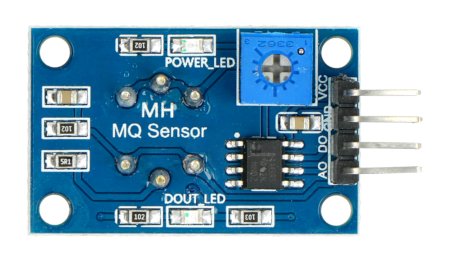Description
The MQ-135 Air Quality Sensor is a popular sensor module used for detecting air quality and measuring various gases, including ammonia (NH₃), nitrogen oxide (NO), alcohol, benzene, carbon dioxide (CO₂), and smoke. It is commonly used in air quality monitoring applications, environmental monitoring, and industrial control systems.
The sensor detects the concentration of benzene, alcohol and smoke in the air, the result can be obtained measuring the voltage on the analog output. The system is supplied with the voltage from 2.5 V to 5 V. It has a digital and analog output, making it compatible with most of the commissioning modules including Raspberry Pi and Arduino.
Specifications:
- Power supply: from 2.5 V to 5 V
- Analog and digital output
- Pins: pin connectors of 2.54 mm raster
- Board sizes: 33 x 20 mm
- It has mounting holes with the diameter: 3 mm
Working Principle:
The MQ-135 works by detecting the change in electrical resistance of the SnO₂ layer when it interacts with various gases. The sensor uses a heating element to heat this layer, and when gases come into contact with the layer, they cause a chemical reaction that changes the resistance. The sensor’s circuit measures this change in resistance and converts it into an analog signal that can be read by a microcontroller.
Pinout (for MQ-135 Module):
The MQ-135 sensor module typically has 4 pins:
- VCC (Power): Connect to 5V power supply.
- GND (Ground): Connect to ground.
- DO (Digital Output): A digital signal that can indicate whether a certain gas concentration threshold has been reached. This output is typically used when you need a simple “high” or “low” indication (whether the air quality is above or below a certain level).
- AO (Analog Output): The analog output that provides a voltage proportional to the gas concentration in the air. This output is used for more precise measurements.
Typical Applications:
- Air Quality Monitoring Systems: To monitor and control air quality, especially in indoor environments (e.g., offices, homes, factories).
- Air Pollution Monitoring: In outdoor applications to measure pollution levels.
- Smart Home Devices: Integration in home automation for managing air quality.
- Industrial Safety: Detection of hazardous gases in factories or labs.









Reviews
There are no reviews yet.